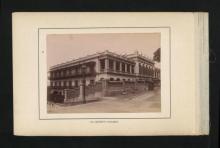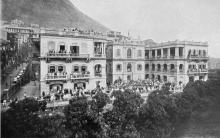Victoria College / Queen's College [1889-1945]
Primary tabs
1884, April 26th, foundation stone is laid. (Reported on page 2 of HK Daily Press, 28 April 1884):
"Saturday afternoon (April 26th, 1884) witnessed the formal commencement of the long projected work of erecting a new building for the accommodation of the institurion hitherto known as the Central School, but which has now been honoured with the more distinguished title of Victoria College. [...]
The new College buildings whic will be erected on the site overlooking Hollywood Road, purchased for the purpose by Sir Arthur Kennedy as far back as 1876, will be in the Doric style, and will be remarkable rather for their severe and academic simplicity and their efficiency to meeet the requirements of the Educational Department than for any pretension to ornateness of design. [...]
1889. July 1st, China Mail page 3:
"The Victoria College
About finished - At last
It seems a somewhat hazardous thing to say, but Victoria College does really appear to be all but finished at last. The building itself is ready for occupation, and the only reason for delaying the opening of the institution seems to be the absence of certain slight though necessary adjuncts, which might easily be supplied in a day or two. But the public will know better, after long experience, than to expect that because there is but little to be done it will be done quickly, and we believe the oft-adjourned ceremenoy of declaing the building open need not be looked for till the termination of the summer vacation. [...]"
1894: Renamed to "Queen's College". (Source: AMO notes)
1945: The demolition date is a guess - Wikipedia says that these buildings were destroyed by allied bombing during WW2, because they were used by the Japanese army.
After the war the school moved to temporary accommodation in Kennedy Road, then to the current site in Causeway Bay.





Comments
Queen's College formerly the
Queen's College formerly the Government Central School is situated in the centre of a district thickly populated by Chinese. It is a very spacious building capable of accommodating 1,000 scholars. The fees are from $1 to $3 per month.
Source: The Tourist's Guide to Hong Kong, with short trips to the Mainland of China … (1897) by HURLEY, R. C.
Chinese names for the school
Notes from Alan C L Yu:
Quite contrary to common perception, the popular Chinese name used nowadays to describe the initial school "Chung Yeung Shue Yuan" (中央書院 back translated as "Central College" rather than "Central School") was never used in history as there was no official Chinese school name in the old days. It was just a loose translation of the English name in recent decades, probably twisted to College to tie in with the modern name "Wong Yan Shue Yuan" (Royal Benevolence College") with "Shue Yuan" being the Chinese equivalent to "College". But "College" was originally used to call those schools run by Western missionaries whereas its Chinese version "Shue Yuan" (originally referring to private learning institutes run by scholars) was borrowed to distinguish these schools from the traditional Chinese run learning institutes. In fact, as there was no official Chinese school name, people usually called the Central School by various Chinese names they like, for example, "The National (Government) Grand School" in Chinese or simply "The Grand School". However, this loosely translated Chinese name "Chung Yeung Shue Yuan" was implanted in everyone's mind to believe this was the official Chinese school name, including publications issued by Queen's College, the government and all historians. Actually, to be faithful to history, "School" should be dfferent from "College". Regarding the origin of the Chinese name of my alma mater, please read the concise version of my research article in the QC 150th Anniversary issue of the school magazine "Yellow Dragon" in 2012.
Post WWII Temporary Accomodation
The school reopened in February 1947 in temporary quarters at 26 Kennedy Road, which was the former Japanese Primary School. China Mail 28 August 1950 refers,